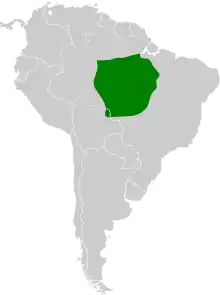| Uniform woodcreeper | |
|---|---|
| Scientific classification | |
| Domain: | Eukaryota |
| Kingdom: | Animalia |
| Phylum: | Chordata |
| Class: | Aves |
| Order: | Passeriformes |
| Family: | Furnariidae |
| Genus: | Hylexetastes |
| Species: | H. uniformis |
| Binomial name | |
| Hylexetastes uniformis Hellmayr, 1909 | |
 | |
| Synonyms | |
|
Hylexetastes uniformis | |
The uniform woodcreeper (Hylexetastes uniformis) is a species of bird in the subfamily Dendrocolaptinae of the ovenbird family Furnariidae.[1] It is found in Bolivia and Brazil.[2]
Taxonomy and systematics
The uniform woodcreeper's taxonomy is unsettled. The South American Classification Committee of the American Ornithological Society and the Clements taxonomy have long treated it as a species with two subspecies.[3][4] The International Ornithological Committee (IOC) formerly treated it as a monotypic species. In July 2023 the IOC lumped what had been Brigida's woodcreeper (then H. brigidai) into the uniform woodcreeper in conformance with the other two taxonomic systems.[1] However, BirdLife International's Handbook of the Birds of the World (HBW) treats uniformis and brigidai as subspecies of the red-billed woodcreeper (H. perrotii).[5]
This article follows the two-subspecies model of H. u. uniformis (Hellmayr, 1909) and H. u. brigidai (da Silva, Novaes, & Oren 1995).[1]
Description
The uniform woodcreeper is 25 to 30 cm (9.8 to 12 in) long. Males weigh 86.5 to 121 g (3.1 to 4.3 oz) and females 95 to 118 g (3.4 to 4.2 oz). It is a large and heavy-bodied woodcreeper with a short and massive bill. The sexes are alike. Adults of both subspecies have smoky brown to olive-brown upperparts with bright chestnut to rufous-chestnut wing coverts, flight feathers, rump, and tail. Their breast is a warmer cinnamon-brown and their belly buffy brown; the latter sometimes has some indistinct fine barring. Their iris is brown to reddish brown or even red, their bill wine-red to brownish, and their legs and feet green or olive. Subspecies H. u. brigidai is somewhat larger and heavier-billed than the nominate, but its otherwise differs only in having pale lores.[6][7]
Distribution and habitat
The nominate subspecies of the uniform woodcreeper is found in the Amazon Basin south of the Amazon River in Brazil between the Madeira and Xingu rivers and south to Mato Grosso state and northeastern Bolivia's Santa Cruz Department. H. u. brigidai is found south of the Amazon from the Xingu River east to the Tocantins and Araguaia rivers. The species primarily inhabits terra firme forest and also occurs in gallery forest and seasonally flooded forest. It is found only rarely in semi-deciduous along the Xingu River. It favors the interior of mature primary forest but also occurs at its edgees and in older secondary forest. It mostly occurs at low elevations but reaches 600 m (2,000 ft) in Serra dos Carajás in Brazil's Pará state.[6][7]
Behavior
Movement
The uniform woodcreeper is year-round resident throughout its range.[6]
Feeding
The uniform woodcreeper's diet is mostly arthropods and also includes small vertebrates such as frogs. It often joins mixed-species foraging flocks to feed from the forest's mid-level to the subcanopy. There it gleans prey from trunks and branches. It also follows army ant swarms, where it forages by sallying to the ground from a low perch to capture prey disturbed by the ants.[6]
Breeding
Little is known about the uniform woodcreeper's breeding biology. Its breeding season appears to include at least June to January. The few known nests were in cavities near the top of large stumps.[6]
Vocalization
The uniform woodcreeper sings mostly at dawn but sometimes during the day.[6] The nominate subspecies' song is a "loud series of about 6 'Weeah weeah - - weeh' notes", and that of H. u. brigidai is similar.[7] The species' calls include "screee-wip, "nnyeah", "nyip, nyeek, nyeek, weeweweweip", "cag notes", and "whinh, whaih, whaih".[6]
Status
The IUCN follows HBW taxonomy and so has not assessed the uniform woodcreeper separately from the red-billed woodcreeper.[8] It is thought to be uncommon to rare across its range and "[a]ppears to be highly sensitive to habitat modification".[6]
References
- 1 2 3 Gill, Frank; Donsker, David; Rasmussen, Pamela, eds. (July 2023). "Ovenbirds, woodcreepers". IOC World Bird List. v 13.2. Retrieved July 31, 2023.
- ↑ Remsen, J. V., Jr., J. I. Areta, E. Bonaccorso, S. Claramunt, G. Del-Rio, A. Jaramillo, D. F. Lane, M. B. Robbins, F. G. Stiles, and K. J. Zimmer. Version 31 May 2023. Species Lists of Birds for South American Countries and Territories. https://www.museum.lsu.edu/~Remsen/SACCCountryLists.htm retrieved May 31, 2023
- ↑ Remsen, J. V., Jr., J. I. Areta, E. Bonaccorso, S. Claramunt, G. Del-Rio, A. Jaramillo, D. F. Lane, M. B. Robbins, F. G. Stiles, and K. J. Zimmer. Version 31 May 2023. A classification of the bird species of South America. American Ornithological Society. https://www.museum.lsu.edu/~Remsen/SACCBaseline.htm retrieved May 31, 2023
- ↑ Clements, J. F., T. S. Schulenberg, M. J. Iliff, T. A. Fredericks, J. A. Gerbracht, D. Lepage, S. M. Billerman, B. L. Sullivan, and C. L. Wood. 2022. The eBird/Clements checklist of birds of the world: v2022. Downloaded from https://www.birds.cornell.edu/clementschecklist/download/ retrieved November 10, 2022
- ↑ HBW and BirdLife International (2022) Handbook of the Birds of the World and BirdLife International digital checklist of the birds of the world. Version 7. Available at: https://datazone.birdlife.org/userfiles/file/Species/Taxonomy/HBW-BirdLife_Checklist_v7_Dec22.zip retrieved December 13, 2022
- 1 2 3 4 5 6 7 8 Marantz, C. A., A. Aleixo, L. R. Bevier, and M. A. Patten (2021). Uniform Woodcreeper (Hylexetastes uniformis), version 1.0. In Birds of the World (J. del Hoyo, A. Elliott, J. Sargatal, D. A. Christie, and E. de Juana, Editors). Cornell Lab of Ornithology, Ithaca, NY, USA. https://doi.org/10.2173/bow.uniwoo1.01 retrieved August 13, 2023
- 1 2 3 van Perlo, Ber (2009). A Field Guide to the Birds of Brazil. New York: Oxford University Press. p. 202. ISBN 978-0-19-530155-7.
- ↑ BirdLife International (2016). "Red-billed Woodcreeper Hylexetastes perrotii". IUCN Red List of Threatened Species. 2016: e.T103661301A93902238. doi:10.2305/IUCN.UK.2016-3.RLTS.T103661301A93902238.en. Retrieved 13 August 2023.